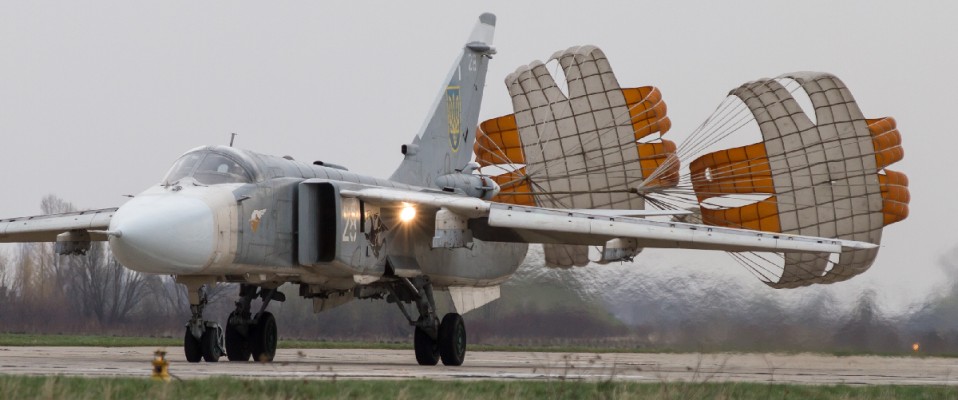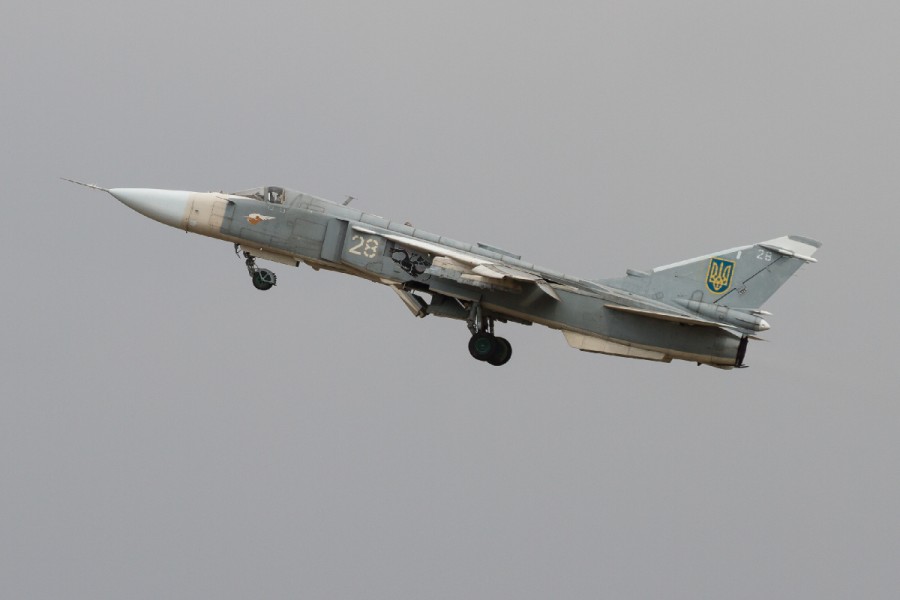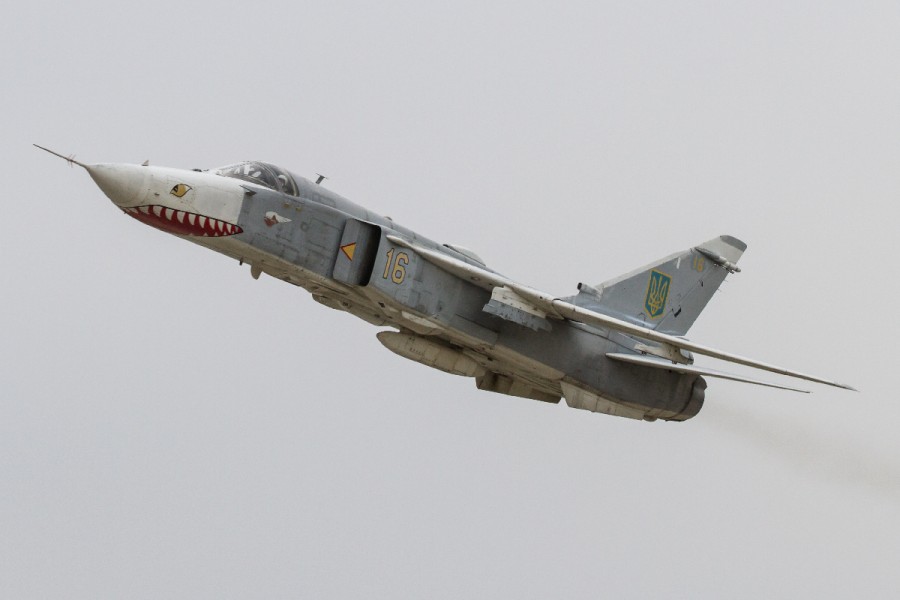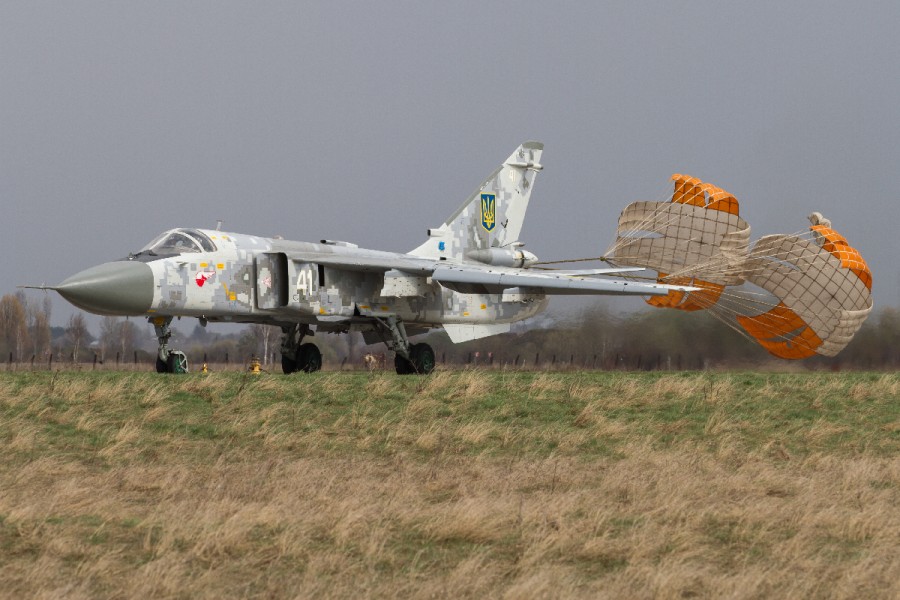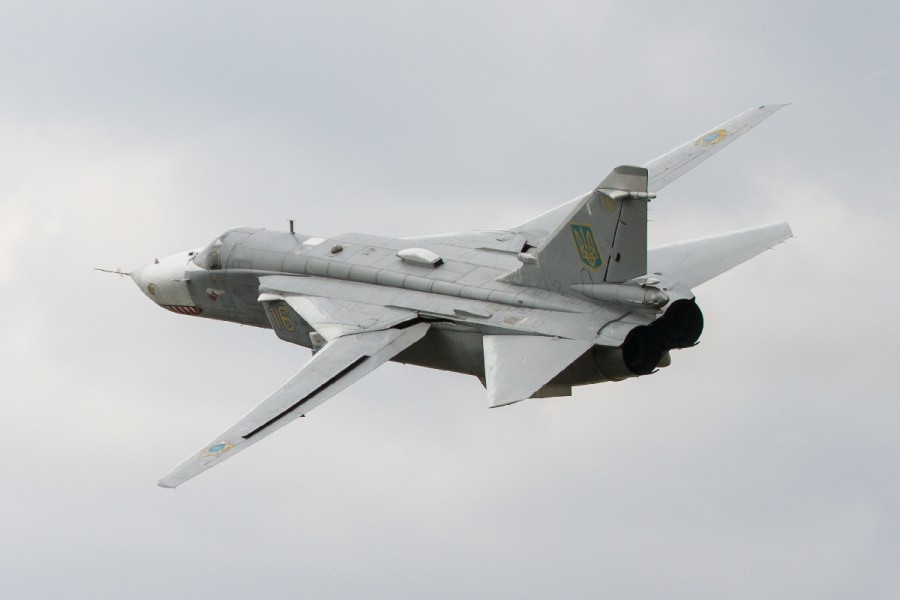Ukrainian Air Force: Petr Franco’s Fencers
Article and Photos by Patrick Roegies, Paul Gross and Hans Looijmans
27 October 2015
Introduction
The Su-24 Fencer has a long history in the Ukrainian Air Force. Presently, more than 30 years after its first appearance in Ukrainian skies, it is still plays a major role as tactical bomber and reconnaissance platform. Even though only one single Brigade of Tactical Aviation (BrTA) is equipped with Su-24 Fencers it still packs a punch.
Fencers in Ukrainian skies
The Ukrainian Fencer fleet was inherited from the former Soviet Aviation regiments which used to be based in the Ukraine as a part of the Soviet Union Air Force.
On the 24th of August 1991, the date when the Ukraine became a sovereign state, the following units were stationed on Ukrainian soil:
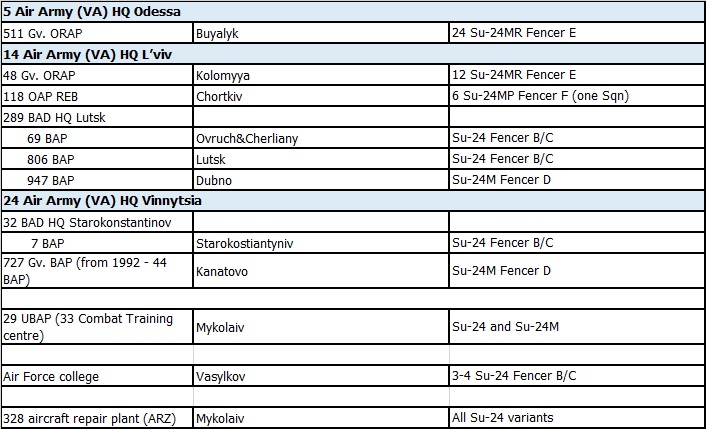
Each Bomber Regiment was equipped with 30 Su-24 (or modernized Su-24M) aircraft. According to unconfirmed sources the number of Su-24’s that were transferred to the Ukrainian Air Force in 1992 was approximately 280 Fencers of all sub models.
Because of defense budget restrains by the new government and the fact that the Ukrainian Air Force -at that time- did not require a large force of long range and medium range attack aircraft the number of active Su-24’s was reduced and many regiments were disbanded.
Most of the Su-24’s that were withdrawn from use were transferred to 1333rd Reserve and Scrap Aviation Base at Bila Tserkva either to be scrapped or to be put in long term storage. By 2004, the Ukrainian Air Force still operated 6 Aviation Regiments equipped with the Su-24 Fencer.
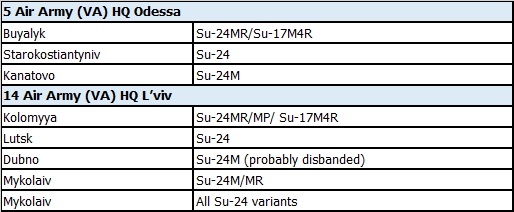
Due to further cutbacks on the defense budget the number of Su-24 regiments was further reduced until only one regiment remained. Currently only the 7th Brigade Tactical Aviation (BrTA) at Starokonstantinov Air Base is still operating the Su-24.
7th Brigade of Tactical Aviation (BrTA) “Petr Franco”
The Brigade is named after Petr Franco, the pioneer of military aviation of the West Ukraine People’s Republic between 1918-1920.
The Sukhoi Su-24 “Fencer” is a twin-engine all-weather interdiction and attack aircraft developed by the Soviet Union. With its variable swept-wing and side-by-side cockpit seating the Su-24 is a very capable as a bomber and a precision strike aircraft.
The first production Su-24 flew in December 1971 and it is often compared to the General Dynamics F-111 Aardvark. Approximately 1400 Su-24’s were produced. They continue to be flown by six countries, including: Algeria, Iran, Russia, Syria, Ukraine and Sudan.
On 20 December 1974, the Regiment replaced their aging Il-28’s with Yak-28 supersonic bombers. Only three years later on 1 December 1977 the Yak-28’s were replaced by the Su-24 due to the disappointing capabilities of the Yak-28. A few years later, the first Su-24M’s were introduced within the Regiment.
In 1999 and 2001 the air crews of the Regiment took part in the air parade over the capital of Ukraine – Kiev participating in the celebration of the Independence Day of Ukraine. From 2000 until 2003 during the reorganization and development of the new structure of the Ukrainian Armed Forces, an experiment was conducted at Starokostiantyniv to create a new professional Armed Forces based on the conventional Regiment structure. The purpose of the experiment was to establish the formation of an Aviation Air Base and Aviation Brigade structure. After a successful experiment and thorough evaluation at Starokonstantinov the experiment was spread throughout the Air Forces of Ukraine.
On 19 May 2004 the 32nd Separate Reconnaissance Air Squadron was formed at Starokonstantinov Air Base. Soon afterwards, in October of 2005 the 32nd Separate Reconnaissance Air Squadron was merged with the Aviation Bombing Brigade, and as a result a new Aviation Bombing-Reconnaissance Brigade was formed at Starokostiantyniv Air Base.
It consisted of three Aviation Squadrons of which were 2 bomber squadrons and 1 reconnaissance squadron including a technical and operational units. The Aviation Brigade was equipped with the Su-24M and Su-24MR in order to perform both rolls. Additionally, the Aviation Brigade received a number of L-39C aircraft mainly used as a cheaper alternative for maintaining flying skills and training capabilities. The Su-24M aircraft are carrying tactical numbers are painted in white, while the Su-24MR have yellow tactical numbers.
In 2005, the personnel of the aviation brigade took part in the exercise “TUGYJ VUZOL” with fulfilling different tasks on the Kyevo -Oleksandrivka firing range.In 2006 the 7th BrTA participated in the flying-training exercise “Clear-Sky-2006”. During that exercise 10 aircraft were deployed to Nikolaev Kulbakino Air Base. In 2007, the Brigade participated in the command-staff exercise “ARTERIYA-2007” with fulfilling different tasks on both the Rovno and Novo-Moscow firing ranges. Followed one year later, in 2008, in the participation of the exercise “MORSKIY VUZOL” during which exercises were conducted on the Chauda and Gora Konchekskaya firing ranges.
For the excellent results in the combat training and successes that were showed during these different exercises on 28 March 2008, and by the order of the Ukrainian President the Aviation Brigade received the honorable name of Petr Franco.
Based on the obtained results in 2009 the 7th BrTA managed to achieve the first place amongst all Aviation Brigades in the Ukrainian Air Forces, as well as for the best results in the combat training. The Brigade was awarded the pennants of the Air Force and the Air Command “West”.
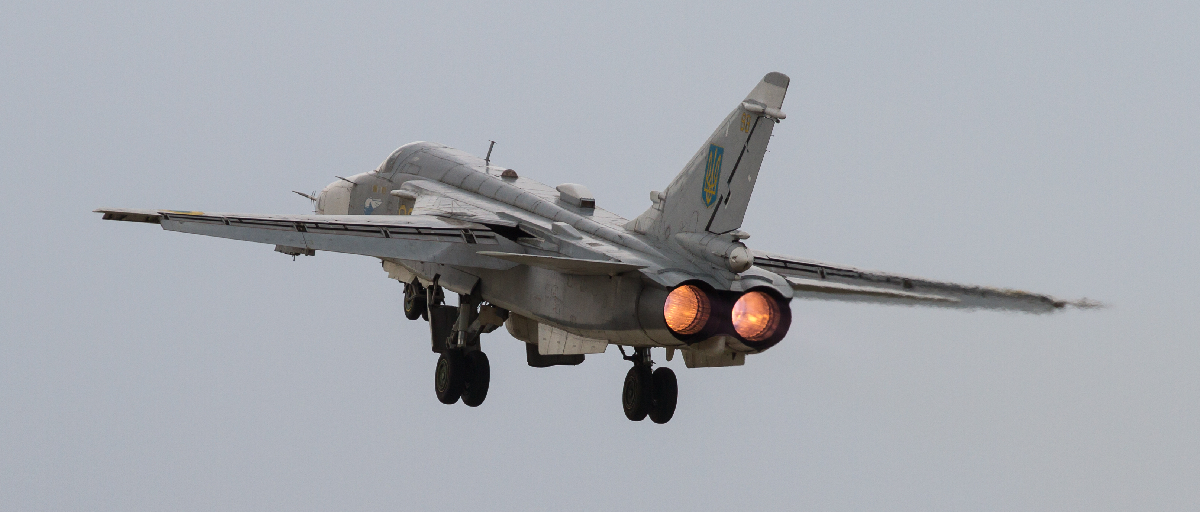
Aircraft modernization program
Having suffered from heavy underinvestment for the last decade due to limited funding, the Ukrainian Air Force was forced to limit the number of aircraft and aircraft types that were refurbished. Only a relatively small amount of An-26, Su-25’s Mig-29’s, Su-27’s and L-39’s actually were refurbished and, in some cases, modernized up to current standards. Since the conflict with Russia commenced early 2014, Ukraine has scaled up refurbishing aircraft back to operational status that would otherwise have become in-operational.
The Su-24 aircraft within the inventory of the Ukrainian Air Force are also in a refurbishment program, but no modernization program has been selected yet. The Russian Air Force is currently upgrading part of their Su-24 fleet to Su-24M2 standard. This includes the entire refurbishment of the aircraft including engines and weapon systems. According to regiment commander Colonel Mikola Kavalenko, there are no plans within the Ukrainian Air Force to upgrade the Su-24’s to M2 standard. There are however thoughts to upgrade the Fencers to enhance their capabilities like using smart bombs. According to an unconfirmed internet report, on 15 September 2014 a contract was signed by the Ukrainian Government and the Nikolaev Aircraft Repair Plant (NARP) for a total value of 2.4 million Euro’s for the refurbishment and modernization of 5 Su-24’s and one Il-76 aircraft. With the delivery of an initial Su-24 delivered to the Ukraine Air Force in November 2014 a mid-life refurbishment program of the Su-24 aircraft seems to actually have started earlier in 2014. After refurbishment at the Nikolaev Aircraft Repair Facility, one Su-24 has been painted in a digital color scheme and it is thought to have some modifications integrated as well.
Because of the tense relationship with Russia, the Ukraine Air Force is developing modernization programs for the aircraft on its own. The Ukraine Air Force hopes to use western weapons in the future. Another option is that the Ukraine Air Force receives western aircraft. It is even rumored that redundant Royal Air Force Tornado GR4 aircraft could be delivered to replace or be added to the Su-24 fleet, but in the current situation this seems unlikely.
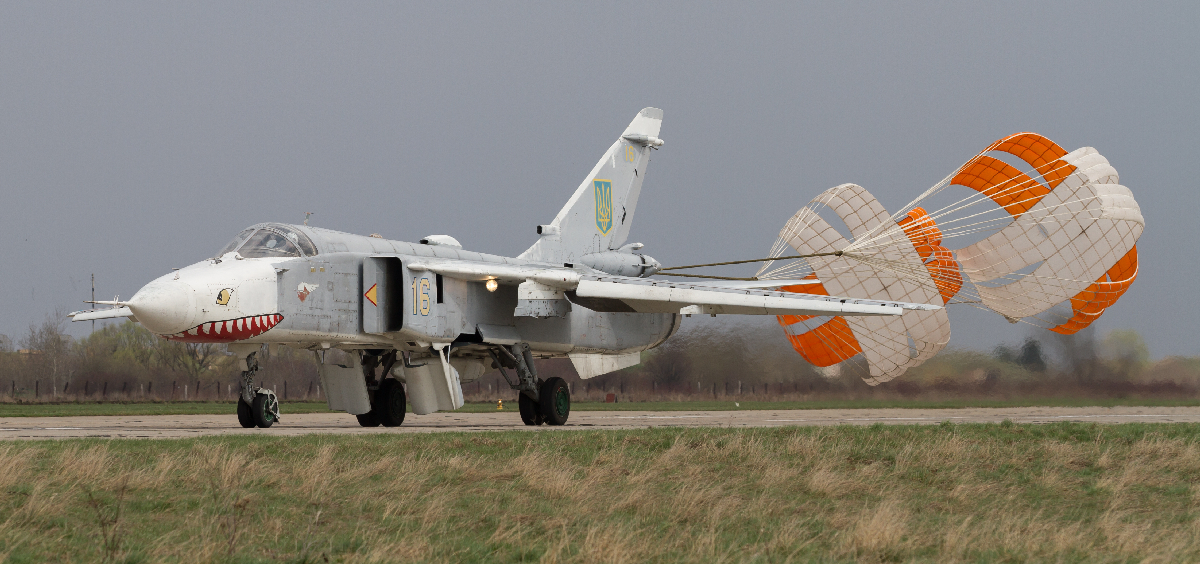
Current operations
All the operational Su-24’s within the Ukrainian Air Force have been appointed to the 7th Fighter Bomber Regiment based at Starokostiantyniv Air Base. Next to these a small number of L-39C aircraft, all of them in the new digital grey color scheme, are in use for advanced training.
The 7th BrTA is appointed the ground attack role and the tactical reconnaissance role. In the inventory of the Regiment at least 16 Su-24’s are fully operational and another 9 to 17 could be airworthy or able to be restored to flying condition on a relatively short period of time. On top of these numbers, there are some 30 Su-24’s stored in relatively good condition.
The current tasks appointed to the 7th BrTA with Colonel Mykola Kovalenko as the Brigade commander are: Maintaining of the combat readiness status, the continuous improvement of combat training level staff training level and sub-units training level, providing high-readiness of the brigade for defense of the liberty, independent and territorial integrity of the Ukraine and providing aid to civilian population and comprehensive providing of the actions in accordance with Government program of the reform and development of the Armed Forces of Ukraine.
The pilots in the Regiment perform missions in both Su-24M and Su-24MR, so there is no further specialization to fighter bomber or reconnaissance crews. A regular operational flying day starts with the traditional weather flight, performed by an L-39 and an experienced crew. During this weather flight, the weather conditions in the area of flight operations are determined. After the aircraft has landed the weather circumstances are briefed. When the conditions are acceptable for flying the aircrews start to prepare their missions for the day during preflight.
The Su-24 uses many different types of bombs in order to perform the air to ground role. In 2014, the 7th BrTA dropped every available type of bomb for the Su-24 during training missions, including napalm, antitank, and mine dispersal units.
All kinds of bombing techniques are practiced during the training missions, dive bombing, loft bombing, and low level bombing from altitudes down to 10 meters flying at speeds of 500 miles per hour.
The Ukrainian Air Force has also developed a special bomb referred to as the OSHAB-250. This bomb is equipped with a delayed fuse and the detonation time can be set by a clock up to a maximum of 72 hours after the bomb is dropped. The Ukrainian Air Force have also developed its own variant of the J-DAM bomb that can be manufactured at much lower cost than the original designed J-DAM.
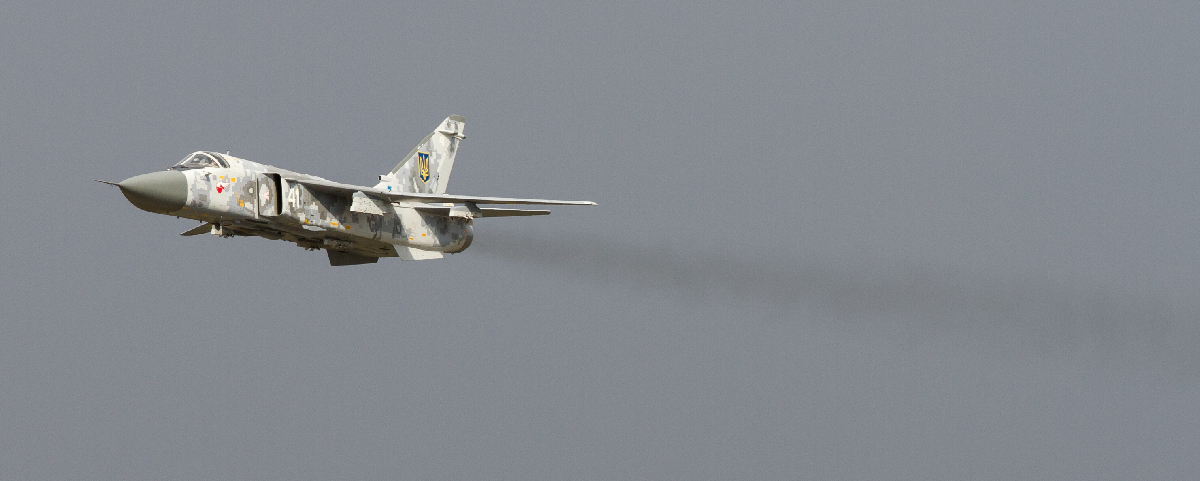
Aircraft losses
The war situation in the Eastern part of Ukraine revealed that the Su-24 is vulnerable to anti aircraft armament (AAA). During the conflict two Su-24’s were lost due to the hostile actions in the region.
On 2 July 2014, one Su-24 was hit by a rebel fired MANPAD. The damaged aircraft landed safely. Another one was shot down in the Lugansk region on 20 August 2014, initially reported as a Su-25. Both pilots managed to eject safely and were recovered by friendly forces.
On 21 March 2014 at 15:15 local time, another of the Su-24M’s crashed upon landing for a yet unknown reason. The crew – squadron commander Lt. Col. Dennis Plug and navigator Lieutenant Oleg Dudnik – sustained only minor injuries after ejecting from the aircraft. A board of investigators looks into the accident.
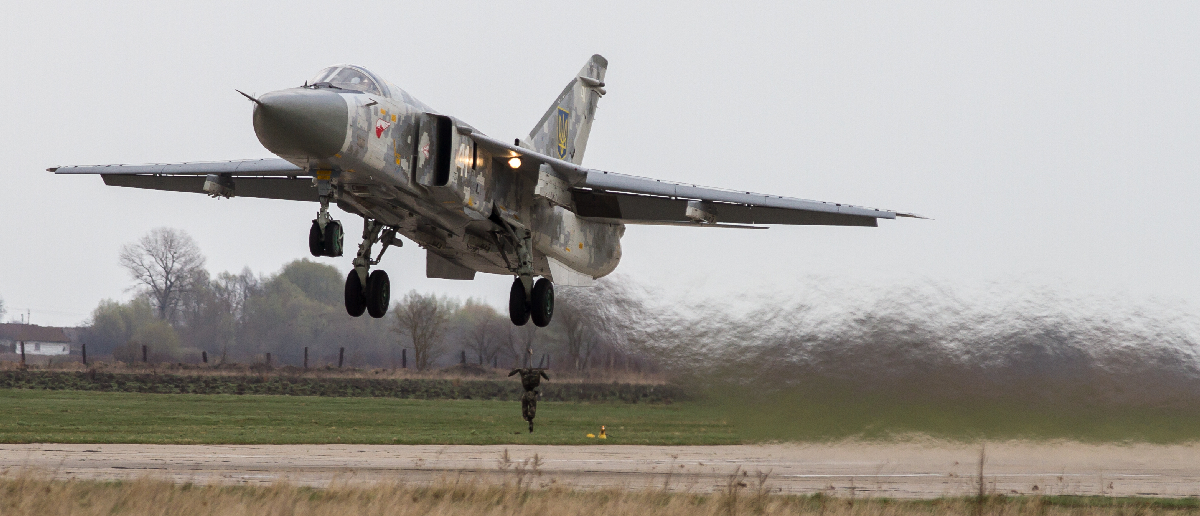
Flankers on TDY at Starokostiantyniv
On April 16th 2015 a contingent of 7 Su-27 Flankers, consisting of two Su-27UB and five SU-27P arrived at Starokostiantyniv Air Base for a deployment. The aircraft belong to 39 independent Squadron of Tactical aviation from Ozerne. Currently Ozerne airbase is overhauled. So all aircraft are relocated to other air bases until their home airbase reopens. Supporting troops and additional equipment were flown in by an An-26 from Vinnitsa airbase.
Upon arrival all Flankers were fully armed with R-27R middle-range, air-to air, with semi-active radar homing (АА-10 Alamo-A) missiles under the fuselage. The bigger missiles under wings are R-27T (АА-10 Alamo-B) with heat (infra-red homing, passive homing using IR seeker head. The smaller missiles under wings are R-73M (AA-11 Archer) short-range air-to-air missiles with infra-red homing. All these missiles were designed in former USSR but produced in Ukraine (in Kiev). Therefore, the Russians can have some problems with armament of their fighters – especially produced for export.
Su-27P bort number 37 is one of the few that has been repainted in the ‘digital’ or ‘pixel’ colour scheme. This schema is applied after overhaul at the MiG Remont maintenance facility in Zaparozhye.
By the end of May these aircraft were still at Starokostiantyniv flying training missions on a regular basis.

Summary:
The current conflict with Russia concerning eastern Ukraine and Crimea has a big impact on Ukraine and therefore on the Ukraine Air Force. Ukraine inherited a great number of aircraft from Russia when it became independent. However, due to limited funds, and because large numbers of aircraft were not needed at the time, a lot of aircraft were taken out of service. Also the number of operational Su-24 aircraft was reduced. Due to the war tensions the need of operational tactical aircraft increased. Several aircraft were downed by AAA.
Though the Su-24M bomber end the Su-24MR reconnaissance aircraft were put through refurbishment programs in small numbers, the Ukraine Air Force is now thinking to develop a modernization program for these aircraft. They cannot, and will not, rely on Russia for modernization programs and weapons anymore, due to the ongoing conflict. Therefore, the Ukraine air Force might look to the West, hoping to use western weapon systems e.g. on the Su-24 aircraft. Otherwise, they will have to develop their own systems. They have the knowledge and the capability to accomplish this if sufficient funds are available.
Patrick Roegies is born and raised in Tilburg, the Netherlands and currently resides in Sittard in the south of the Netherlands where he lives with his wife Joyce. Patrick graduated from a technical study at the HTS in Tilburg in 1997. He currently works as a head of an equipment engineering department in the south of the Netherlands.
His passion towards aviation started at the age of 7 in 1977 when his father took him to nearby Gilze Rijen Air Force base where he witnessed his first howling F-104 Starfighters which were practicing and as a result he got addicted immediately. The F-104’s were present in order to determine a tactic to create a diversion for the “train highjack” which was going on in the Netherlands at that time. The F-104’s were meant to create a diversion by performing an overshoot, kicking in the afterburner directly over the train, creating confusion with the hijackers and enabling the police to master the hijackers. This action has actually been performed and worked.
This is when his passion towards aviation was born. He got permission from his parents to visit the airbase every free hour he had and his father showed him the way by bicycle. Patrick got his first camera in 1984 which was a Canon T50 and shot Kodachrome 64 slides of mainly military aircraft. He changed his gear in the mid-nineties to Nikon and is a Nikon user ever since.
When Patrick obtained his driver license in 1989 he started to visit airbases all over Europe and from 1997 onwards he made worldwide visits to military airbases.
In order to further professionalize his work as an aviation photographer and journalist he started to write military aviation related articles based upon his visits to various nations and their Air Forces. He managed to publish his first article in 2003 and increased the numbers of publications every year.
Patrick can be reached at: [email protected]


